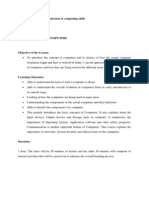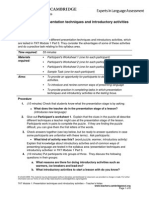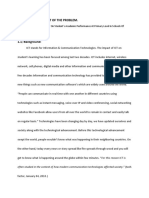Logic Gates Part 1
Logic Gates Part 1
Uploaded by
api-269738112Copyright:
Available Formats
Logic Gates Part 1
Logic Gates Part 1
Uploaded by
api-269738112Original Title
Copyright
Available Formats
Share this document
Did you find this document useful?
Is this content inappropriate?
Copyright:
Available Formats
Logic Gates Part 1
Logic Gates Part 1
Uploaded by
api-269738112Copyright:
Available Formats
Logic gates part 1
Lesson plan
1
Lesson Plan
General Information:
o Topic: logic gates.
o Course code: ELT 205
Learning Objectives:
General Learning Objectives:
The Trainees
1. Come on time.
2. Discuss information about the topic.
3. Interact with the teacher.
4. Listen to each other.
5. Answer the worksheet on time.
6. Take notes.
7. Clean the classroom at the end of the lesson.
Specific Learning Objectives:
The Trainees
1. Describe Logic Gates (AND, OR, NOT).
2. Explain logic gates (Reorganization).
3. Distinguish between (AND, OR, NOT).
4. Find out how to find the truth table.
5. Explain how to connect the experiment on the test board
(Reorganization).
6. Fill in the truth table using test board (Transfer).
Didactic Analysis:
In this lesson l will explain the basic Logic Gates. There are lots of reasons to
learn logic gates. Here are some of those reasons:
Digital logic is the foundation for digital computers. If you want to understand
the innards of computers you need to know digital logic. Digital logic has
relations to other kinds of logic including Formal logic gates - as taught by
many Electrical Technology departments and Electronics Technology
department so, in learning logic gates you learn something that helps you
elsewhere. For many students to learning logic gates is fun and important in
our life.
In this lesson I choose 3 methods. I start with opening, I welcome the trainees
and take the attendance. Then I start with the opening in a classroom
conversation, then ask the trainees what is the language of digital and what
are the benefits of the study of logic gates and why do we use logic gate in
processing units to the trainees. The goal is to use classroom conversation.
When the trainees answer the question in this time the trainees are active in
the classroom.
After that I start for body, I also use classroom conversation about the video
before it run. And I ask the trainees about the video how many logic gates in
the video and what is the name of logic gates in order to the trainees are
focus when show the video. Then show to the trainees a small video to the
trainees see and listen the video. After that I use the mind map about take
every student a small card to write any gates to see in the video. The goal
from use the mind map is focus the students when shown the video. Next I
use the lecture I explain about 3 logic gates on the whiteboard about truth
table, Boolean expression, symbol, and electrical circuit to the trainees listen
and discuss with the trainer. The goal from using lecture gives the trainees all
the information about the logic gates. At this point, also I use classroom
conversation when give the trainees the worksheet about (AND, OR, NOT)
logic gates to the trainees answer the question and write the result on the
whiteboard. The goal from use worksheet to assist in retaining topic
information. Also I use the group work for experiment. I give the trainees an
experiment about some logic gates. the trainees connect the experiment on
the test board and I discuss the result with the trainees. The goal from this is
to motivate the trainees to work and the goal from using the experiment in
order to clarification to trainees how to use the logic gates and how they work.
After that I use the individual work in the close of the lesson. I give the trainees
a quiz about logic gates. The goal from individual work is to ensure that
students good comprehension of the lesson and to ensure that students have
reached the lesson objective.
Why I used these methods:
Using the lecture on the power point and white board:
To explain the logic gates (AND, OR and NOT) and give
exercise.
Using the class room conversion for the task ,work sheet and exercise:
To give them some question and worksheet.
To discuss about the solution of the exercise.
To make the trainees solve the worksheet on the whiteboard.
Using individual work in the worksheet:
To motivate the trainees to work.
To individually think and solve problems.
To assess the trainees.
Using the group working the experiment:
To give the trainees experiment and help each other.
To make each group to do the truth table and simulate on the
test board.
List of attached teaching material
Power point.
Whiteboard. .
Pen for whiteboard.
Power supply.
Wires.
Test board for the experiment.
Quiz.
Projector and computer.
Video.
Handout.
Worksheet.
Small card for mind map.
Media Analysis:
Using the whiteboard:
To explain the logic gates.
Writing the answer for worksheet.
Using the projector:
To help them to understand how a logic gates works.
To make the solution of tasks easier.
Using individual work:
To motivate the trainees to work.
To individually think and solve problems.
To assess the trainees.
Give them worksheets:
To assist in solving tasks.
To assist in retaining topic information.
Assign Quiz:
To ensure that students comprehension of the lesson.
To ensure that students have reached the lesson objective.
Overview of the Intended Process:
Opening / Entrance / Motivation
Methodology
Media
Time
Minutes
Expected Trainer-action Expected Trainee-action
The trainer welcomes the trainees
and takes the attendance.
The trainees welcome and answer the
trainer.
_
Slide 2 2 min
The trainer asks the trainees what is
the language of digital?
What are the benefits of the study
of logic gates?
Why do we use the logic gates in
processing unit?
The trainees answer the questions.
Classroom
conversation
Slide 3 2 min
Body (Information / Elaboration)
Methodology
Media
Time
Minutes
Expected Trainer-action Expected Trainee-action
The trainer asks the trainees
before showing the video the how
many logic gates do we have and
what is the name of the logic
gates?
The trainees answer the questions.
Classroom
conversation
2 min
The trainer shows to the trainees a
small video about logic gates
The trainees see and listen the video.
_
Projector
video
Slide 4
4 min
The trainer discuss with trainees
about the answer
The trainees put the answer on the
whiteboard.
Mind map
_ 3 min
The trainer explains about AND, OR
and NOT logic gates on the
whiteboard about Truth table,
Boolean expression, symbol, and
The trainees listen and discuss with the
trainer.
Lecture
Whiteboard
Slide 5
10 min
electrical circuits.
The trainer gives the trainees
handout.
The trainees takes the handout.
_
Handout 1min
The trainer gives the trainees the
worksheet about the logic gates.
The trainees answer the task and write
the result on the whiteboard.
Classroom
conversation
Whiteboard
Slide 6
5 min
The trainer explains how to
connect the experiment on the test
board.
The trainees see and listen the
experiment with the trainer.
Lecture
Test board
Slide7
3 min
The trainer gives the trainees the
experiment about some logic
gates.
The trainees connect the experiment
on test board and answer the task.
Group
Work
Test board
Slide8
10 min
.
Close (Reflection, Exercises, Homework, Feedback)
Methodology
Media
Time
Minutes
Expected Trainer-action Expected Trainee-action
The trainer gives the trainees quiz
about the topic...
The trainees answer the Quiz.
Individual
work
Slide9 6 min
In the summary the trainer asks
trainees to know the feedback.
The trainees answer the questions.
Classroom
conversation
Slide 10 2 min
You might also like
- Principles of Materials AdaptationDocument20 pagesPrinciples of Materials AdaptationAniza Mohd Hanafiah33% (3)
- My Thesis Proposal in MSITDocument74 pagesMy Thesis Proposal in MSITSofia SienesNo ratings yet
- Logic GatesDocument7 pagesLogic Gatesapi-250028527No ratings yet
- Research Question Type of Data How To Get Time Allocation How To Analyze 1 Student Test Score Test: Pre Test Before Treatment CorrectingDocument12 pagesResearch Question Type of Data How To Get Time Allocation How To Analyze 1 Student Test Score Test: Pre Test Before Treatment CorrectingGiueseppe MeazzaNo ratings yet
- Lesson Plan 2Document2 pagesLesson Plan 2api-240777675No ratings yet
- Observation 4 Lesson PlanDocument6 pagesObservation 4 Lesson Planapi-702381076No ratings yet
- Legend: Dennis PlottDocument6 pagesLegend: Dennis PlottAnonymous 94I9knNo ratings yet
- Name School Subject Form Number of Students Date of Lesson Time Title of Lesson Unit 1.1 Understanding WaveDocument5 pagesName School Subject Form Number of Students Date of Lesson Time Title of Lesson Unit 1.1 Understanding WavehitampandaNo ratings yet
- Millicent Atkins School of Education: Common Lesson Plan TemplateDocument10 pagesMillicent Atkins School of Education: Common Lesson Plan Templateapi-383908049No ratings yet
- Assignment in Methods and Strategies in Teaching Business CoursesDocument2 pagesAssignment in Methods and Strategies in Teaching Business CoursesLeonard Andrew ManuevoNo ratings yet
- Techniques For Effective Teaching Training WorksheetDocument97 pagesTechniques For Effective Teaching Training Worksheetehikhuenmen samsonNo ratings yet
- L S PLC TableDocument4 pagesL S PLC Tableapi-249238142No ratings yet
- LESSON PLAN For Introduction To Computing SkillsDocument8 pagesLESSON PLAN For Introduction To Computing SkillsRajen RajNo ratings yet
- Keystone ProjectDocument3 pagesKeystone Projectapi-308647823No ratings yet
- Lesson Plan Sub Day 8Document4 pagesLesson Plan Sub Day 8api-571898884No ratings yet
- Lesson 3 CiDocument19 pagesLesson 3 Ciapi-252424167No ratings yet
- Section 7 4 Lesson PlanDocument6 pagesSection 7 4 Lesson Planapi-272198179No ratings yet
- Round and Round The Unit Circle: Resource ID#: 46782 Primary Type: Lesson PlanDocument3 pagesRound and Round The Unit Circle: Resource ID#: 46782 Primary Type: Lesson PlanTitser LaarniNo ratings yet
- Lesson 3Document3 pagesLesson 3api-437998606No ratings yet
- Ict Lesson PlanDocument3 pagesIct Lesson Planapi-241840332No ratings yet
- Trts NewmanDocument7 pagesTrts Newmanapi-282627090No ratings yet
- Final Manual Template Sophia1Document39 pagesFinal Manual Template Sophia1api-239232825No ratings yet
- Tws 5 HDocument42 pagesTws 5 Hapi-242296907No ratings yet
- Discussion 4 Math PlanDocument6 pagesDiscussion 4 Math PlankrweltonNo ratings yet
- SESSION GUIDE 12 Pre Reading StrategiesDocument31 pagesSESSION GUIDE 12 Pre Reading Strategieswelfredo yuNo ratings yet
- Digital Product Lesson PlanDocument6 pagesDigital Product Lesson Planapi-317619349No ratings yet
- Elisabeth Person: NSU Lesson Plan FormatDocument3 pagesElisabeth Person: NSU Lesson Plan Formatapi-437998606No ratings yet
- Ipg For Act 2Document2 pagesIpg For Act 2api-291180188No ratings yet
- RPP PECAHANDocument10 pagesRPP PECAHANAristya DewiNo ratings yet
- Lesson Plan For Communicative EnglishDocument3 pagesLesson Plan For Communicative EnglishnuruludetNo ratings yet
- MerveDocument2 pagesMerveapi-643850759No ratings yet
- Flipped Classroom ActivityConstructorDocument10 pagesFlipped Classroom ActivityConstructorPrakash Kumar SenNo ratings yet
- Fatima Obaid - H00360652: Date: 1-11-2020Document2 pagesFatima Obaid - H00360652: Date: 1-11-2020Fatima ObaidNo ratings yet
- TKT Module 1 Task Type 3 Introduction To Sequencing Tasks PDFDocument7 pagesTKT Module 1 Task Type 3 Introduction To Sequencing Tasks PDFRachel Maria RibeiroNo ratings yet
- Finalized Lesson PlanDocument9 pagesFinalized Lesson Planapi-265324068No ratings yet
- ISTE Workshop Writing Effective Conference Papers: Paper Planning TemplateDocument53 pagesISTE Workshop Writing Effective Conference Papers: Paper Planning Templatepatil_raaj7234No ratings yet
- TKT Module 1 Presentation Techniques and Introductory Activities PDFDocument8 pagesTKT Module 1 Presentation Techniques and Introductory Activities PDFRachel Maria RibeiroNo ratings yet
- Revised Lesson 3Document4 pagesRevised Lesson 3api-340802940No ratings yet
- Name The Steps - Lesson PlanDocument2 pagesName The Steps - Lesson Planniranjankumar79No ratings yet
- Teacher Training - WebBoxDocument10 pagesTeacher Training - WebBoxabhasin0902No ratings yet
- CEP Lesson Plan Form: Content Standard(s) Addressed by This Lesson: (Write Content Standards Directly From TheDocument7 pagesCEP Lesson Plan Form: Content Standard(s) Addressed by This Lesson: (Write Content Standards Directly From Theapi-491544575No ratings yet
- SOW CE62021-2-MALG 16 WeeksDocument10 pagesSOW CE62021-2-MALG 16 WeeksMichael HillNo ratings yet
- Tcs 2Document3 pagesTcs 2thelastkilleranuragNo ratings yet
- Nov 9Document5 pagesNov 9api-341342663No ratings yet
- Mertic Conversion Lesson PlanDocument6 pagesMertic Conversion Lesson Planapi-538661431No ratings yet
- Teacher's Guide: Space Bubbles Programming Scheme of WorkDocument14 pagesTeacher's Guide: Space Bubbles Programming Scheme of WorkIván Vega JurisNo ratings yet
- 5 Sem 21 Scheme SyllabusDocument23 pages5 Sem 21 Scheme SyllabusAditya RanjanNo ratings yet
- IELTS Listening NotesDocument4 pagesIELTS Listening NotesMohammad ArsalanNo ratings yet
- Oct 3Document5 pagesOct 3api-341342663No ratings yet
- Assignment 2Document4 pagesAssignment 2Logeswary GanesanNo ratings yet
- Tech AssDocument3 pagesTech Assapi-663289533No ratings yet
- LP Direct Instruction Lesson Plan TemplateDocument8 pagesLP Direct Instruction Lesson Plan Templatecedes414No ratings yet
- ReflectionDocument6 pagesReflectionapi-344399401No ratings yet
- wk2 - Wednesday Ict LPDocument7 pageswk2 - Wednesday Ict LPapi-256481403No ratings yet
- Full Lesson Plan Kino MatsuuraDocument3 pagesFull Lesson Plan Kino Matsuuraapi-582783511No ratings yet
- Week 7Document52 pagesWeek 7Aruna Devi Associate ProfessorNo ratings yet
- Centers Based Lesson Planning TemplateDocument4 pagesCenters Based Lesson Planning Templateapi-239232218No ratings yet
- Lesson Plan: Formative: The Minute Math Drill Will Allow The Teacher To See HowDocument3 pagesLesson Plan: Formative: The Minute Math Drill Will Allow The Teacher To See Howapi-299683204No ratings yet
- Action ResearchDocument13 pagesAction Researchapi-215627636No ratings yet
- Creating A CohesiveDocument11 pagesCreating A CohesiveGloria BrogdonNo ratings yet
- Gagne's Conditions of Learning Theory - International Centre For Educators' StylesDocument12 pagesGagne's Conditions of Learning Theory - International Centre For Educators' Stylesjocadaing16No ratings yet
- Jamaica PEDocument30 pagesJamaica PEMyca HernandezNo ratings yet
- National Curriculum Teachers Guide 7 9 English1 PDFDocument114 pagesNational Curriculum Teachers Guide 7 9 English1 PDFsamahaseNo ratings yet
- An Analysis On Impact of ICT On Student 1Document10 pagesAn Analysis On Impact of ICT On Student 1Mahrukh JawedNo ratings yet
- Writing Test IELTS PrepppDocument3 pagesWriting Test IELTS Prepppsamantha sarahhNo ratings yet
- INDE1001 - Workshop 4.1 - ITP Metrics Worksheet - Capabilities by SaeedDocument1 pageINDE1001 - Workshop 4.1 - ITP Metrics Worksheet - Capabilities by Saeedsaid.dahir007No ratings yet
- Tos Midterm Exam World ReligionsDocument1 pageTos Midterm Exam World ReligionsJhanay Jam CalzadaNo ratings yet
- Verano Beauty Lesson#1.1Document3 pagesVerano Beauty Lesson#1.1beautéNo ratings yet
- Lesson Plan Week 1Document2 pagesLesson Plan Week 1api-533549420No ratings yet
- Camp Tinio National High SchoolDocument4 pagesCamp Tinio National High SchoolMia Lei LalantaconNo ratings yet
- Length of Straight and Curve LinesDocument5 pagesLength of Straight and Curve LinesbensudinNo ratings yet
- GA 11 Unit 8 ListeningDocument3 pagesGA 11 Unit 8 Listeningbjyx10No ratings yet
- The Grammar LessonDocument2 pagesThe Grammar LessonOrlando SaliviaNo ratings yet
- Department of Education: Republic of The PhilippinesDocument4 pagesDepartment of Education: Republic of The PhilippinesJohn Rex Villanueva100% (1)
- Six Learning Situations in An Ece ClassroomDocument8 pagesSix Learning Situations in An Ece ClassroomFrancis MbeweNo ratings yet
- Maslach Burnout Toolkit Educators Intro SheetDocument1 pageMaslach Burnout Toolkit Educators Intro SheetMyint ZuNo ratings yet
- ARABIC LANGUAGE DLL Level 6 1st Quarter WEEK 9Document3 pagesARABIC LANGUAGE DLL Level 6 1st Quarter WEEK 9Haniah Abdullah100% (2)
- Creating A Culture of Inquiry SD 23 IltDocument4 pagesCreating A Culture of Inquiry SD 23 Iltapi-532711018No ratings yet
- Contextualization-Of-learning-materials English and Short VersionDocument22 pagesContextualization-Of-learning-materials English and Short Versioncharles stone panuncilloNo ratings yet
- Education System in The Philippines (Position Paper)Document6 pagesEducation System in The Philippines (Position Paper)Taniya50% (2)
- Adult EducationDocument2 pagesAdult EducationinfotandhmedicalNo ratings yet
- Module 3 Lesson 3 NewDocument25 pagesModule 3 Lesson 3 NewFajad NonakanNo ratings yet
- Financial AidDocument1 pageFinancial AidSirius BlackNo ratings yet
- Daily Lesson Plan - CookiesDocument2 pagesDaily Lesson Plan - CookiesCONSIGNADO ALTHEA MARIENo ratings yet
- Success: Unit 3 Managing and Caring Self Module 12 Learning To Be A Better StudentDocument13 pagesSuccess: Unit 3 Managing and Caring Self Module 12 Learning To Be A Better StudentDorothy Yvonne LorenteNo ratings yet
- Running Head: A Critique of Swartz Creek High School Using Blankstein 1Document15 pagesRunning Head: A Critique of Swartz Creek High School Using Blankstein 1api-458881694No ratings yet
- Make Their Own Sombrero Vueltiao: Sombrero Vueltiao Pictures Video of History of Sombrero VueltiaoDocument4 pagesMake Their Own Sombrero Vueltiao: Sombrero Vueltiao Pictures Video of History of Sombrero VueltiaoClaribel ValdezNo ratings yet
- Day 3 Las - Ratio and ProportionDocument7 pagesDay 3 Las - Ratio and ProportionPrecious Joy Torayno BayawaNo ratings yet

























































































